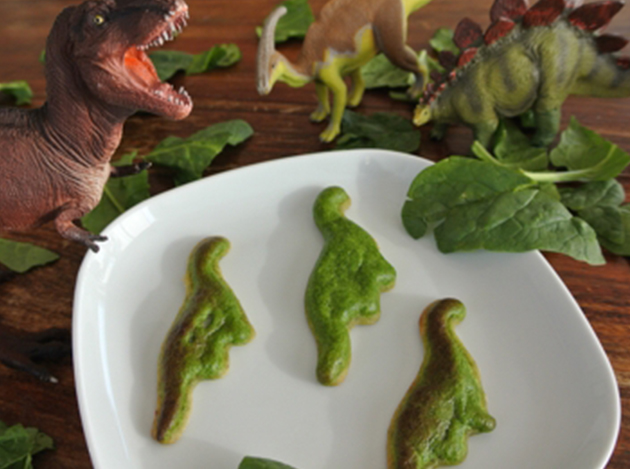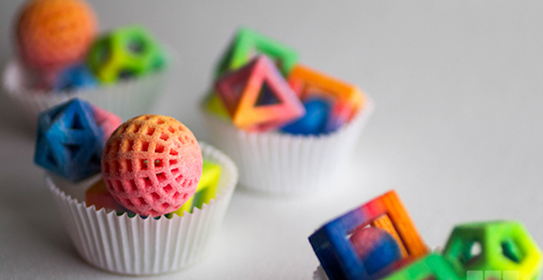(Courtesy of My Modern Met)
The holidays are all about food, family, and fun, but let’s be honest… sometimes all we want is the food! Food is something that’s universal and brings us together, no matter where we are or who we’re with. It’s the great unifier that helps us to feel close during the holidays, and 3D printing is aiming to make food more accessible, healthy, and sustainable, no matter what your food needs or preferences.

(Courtesy of Natural Machines)
You may have heard about the 3D printing of food–but what about utilizing food (or in this case, food byproducts) as a resin in 3D printing non-food items? Filtered used cooking oil is being utilized by Professor Andre Simpson at the University of Toronto to create biodegradable and compostable 3D printing resin for stereolithography (SLA) printing. Simpson is the director of the school’s Environmental NMR (Nuclear Magnetic Resonance) Center, which is dedicated to the development of novel approaches for studying environmental processes at the molecular-level. Simpson and his team discovered the use for the cooking oil when searching for a way to spend less on SLA resin for use in their research, and realized the plastic resin’s molecules were similar to fats that can be found in cooking oil. Not only does the cooking oil resin cut costs, but also provides a way to reuse and recycle waste cooking oil.
Meanwhile, much research is being conducted on how to best 3D print food itself. The most common process used to 3D print food is the one most people are familiar with: the fused deposition modeling (FDM) 3D print process, often utilized in desktop 3D printers. 3D printing food works much like a regular FDM 3D printer in the sense that a viscous material is deposited in layers onto a surface to create a final object. Other additive processes like selective laser sintering (SLS), which would utilize food powder, are being investigated, but it’s still debatable whether these processes are viable for food printing or not. With the 3D processes usable for 3D printing foods being limited, the foods that can be 3D printed are also somewhat finite; as the most common method available, FDM food printing requires paste-like inputs like purées, mousses, and other viscous foods.
3D printing food comes with a list of costs vs. benefits when compared with traditional food preparation. On the benefits side, 3D printing food can be time-saving, as the printer does the preparation for you while you can attend to other things. 3D printing also enables users to customize their food according to special needs or desires (like omission of certain ingredients, or inclusion of a particular design), and along with this, there’s an element of creativity, as intricate designs and food art can be incorporated which otherwise might be very difficult or impossible to create. Alternatively, as previously noted, 3D printing is limited in the types of food it can create and the ingredients that can be extruded; 3D printing food also doesn’t usually include cooking as part of the prep process (although some printers do cook and prepare 3D printed foods all in one device). Price is also a limiting factor, as food printers are currently in the thousands of dollars, and as with any 3D print process, there is the risk of failure of the final product.

(Courtesy of Natural Machines)
All this being said, there are some food-related tasks that 3D printing could really excel at as the technology improves. These include meeting food prep needs by utilizing healthier ingredients; 3D printing food at home offers the convenience of any pre-packaged and processed food, but with 3D printing, the user gets to choose the ingredients that go into a dish, thus increasing the healthiness of the product and awareness of the consumer about what’s going into their food. Additionally, because of the technology’s ability to print creative shapes, foods that normally might be unappealing to adults and children can take on more interesting and enticing shapes and designs, like vegetables extruded into the shape of dinosaurs.
3D printing can also help create more sustainable foods with less food waste, in part because foods can be made more aesthetically appealing with the help of the 3D print process. Designer Susana Soares notes that “the influence of aesthetics on the choice of food is well documented. The appearance of the food influences the acceptance and the taste experience.” Soares explores how we can reduce meat consumption (an environmentally unsustainable practice) by substituting insects as a protein source, as insects produce less methane and consume less water in their production. As eating insects is a practice generally rejected in the Western world, 3D printing can help transform this initially unappetizing protein source into a more attractive shape. This same practice can also be applied to “ugly” or damaged produce, or otherwise leftover but perfectly edible manufactured food product that ordinarily would be thrown out.
Research is still being conducted to determine the best textures and methods for 3D food printing, which will gradually help to bring down the price of food 3D printers, make CAD software that’s accessible to the average consumer, and help the public to accept this new method of food creation. The possibilities are truly endless with technology, from the ability to produce creative shapes using puree-like foods for dysphagia patients, to 3D printing nutritional supplements directly into foods, to preparing food for astronauts in space, 3D printing food will allow us to meet particular nutritional needs, be more creative in our food preparation, and truly customize the food we prepare for ourselves each day.
At the end of the day, there’s nothing wrong with the way we currently prepare food–but just as we continue to move forward with our development of other forms of technology to make our lives easier and/or more interesting, research and development of food 3D printing continues to enhance and revolutionize our everyday experience of how we create and consume food.

